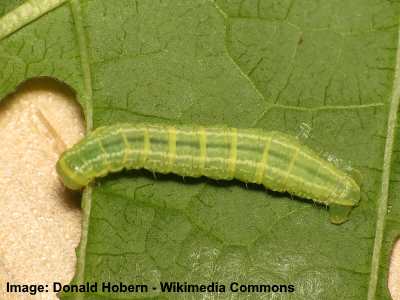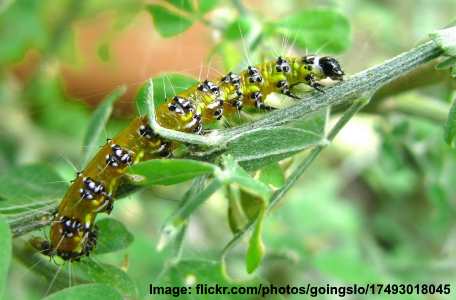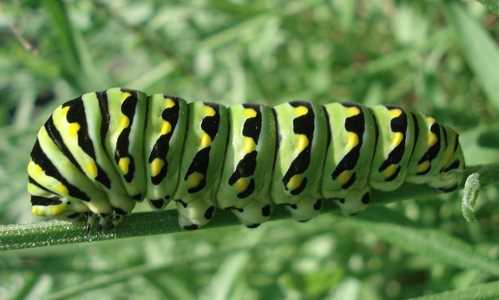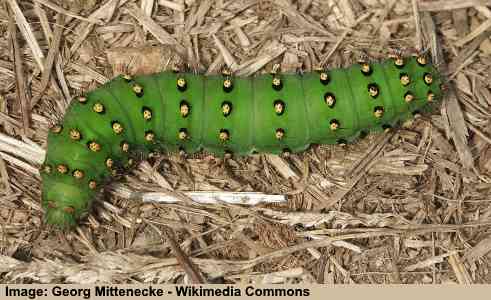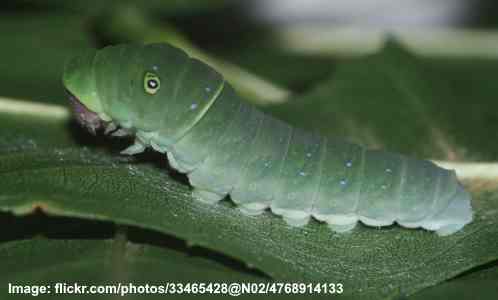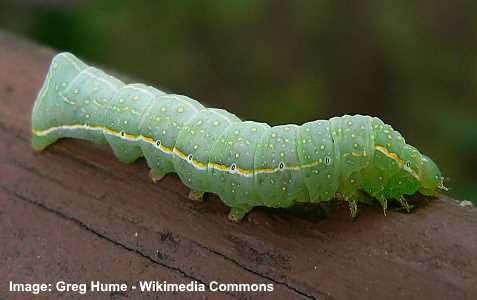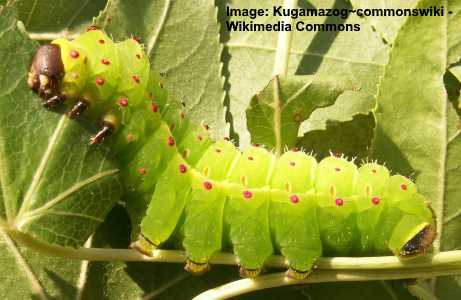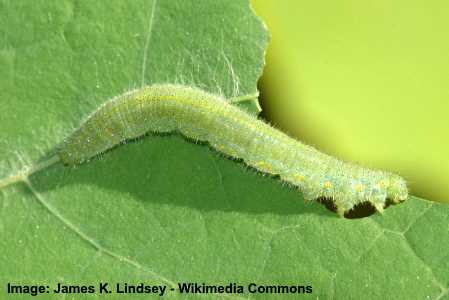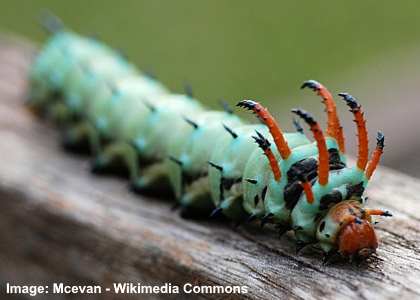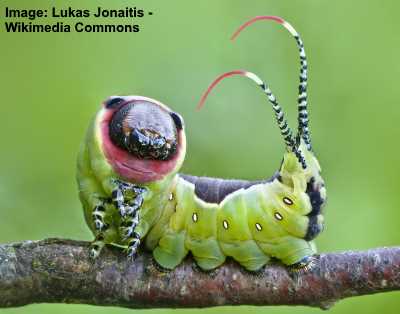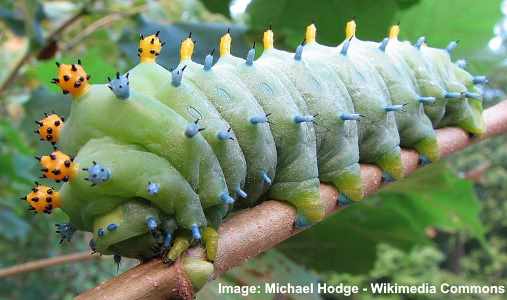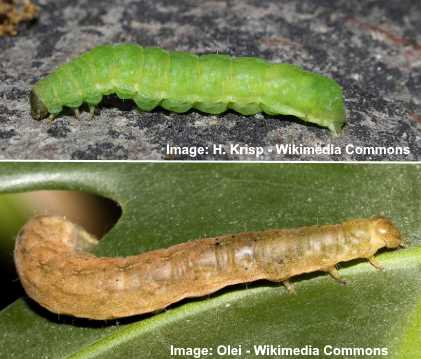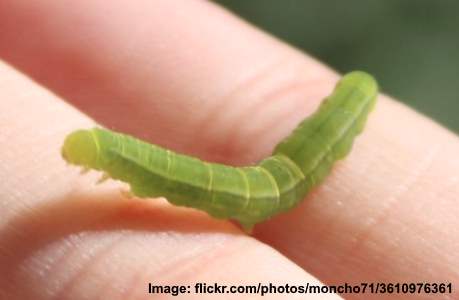50 Green Caterpillars (with Pictures): Caterpillar Identification Guide
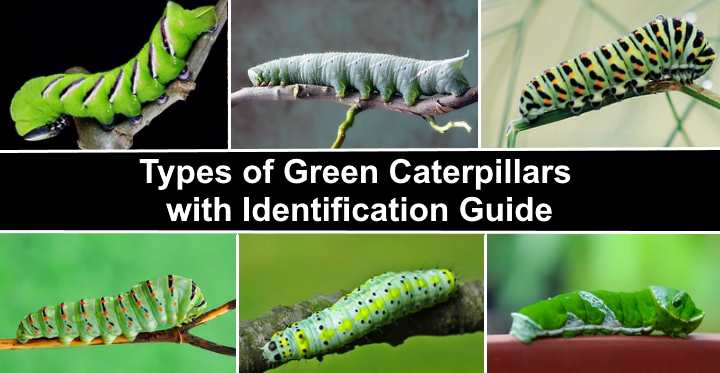
Have you ever come across a green caterpillar in your garden and wished you could identify it? This article is a visual guide designed to help you identify 50 different types of green caterpillars. Our comprehensive green caterpillar identification chart will assist you in recognizing and distinguishing the identifying features of various green caterpillar species.
Green caterpillars are some of the most recognizable crawling insects in the wild. All types of caterpillars, including green ones, gorge on a diet of plant and tree leaves. Green caterpillars are some of the largest and fattest insects in the Lepidoptera order.
Caterpillars are larvae before they turn into moths or butterflies. Most species of green caterpillars have smooth bodies and are completely harmless. Green caterpillars aren’t poisonous, but some have spikes or spines that can give you a nasty sting. In fact, one green caterpillar species even spits acid! So, it is always better to identify the caterpillar species before picking one up.
Green Caterpillar Identification
You can identify green caterpillars by their size, specific markings, spines or spikes, and plant food they feed on.
When trying to identify types of caterpillars, it’s good to remember that they go through different stages of growth. Sometimes, baby larvae of green caterpillars can look different from mature caterpillars. The descriptions of different caterpillars in this list are of mature ones before they enter pupation.
Types of Green Caterpillars with Their Names and Pictures: An Identification Guide
Here are different green caterpillars you may find crawling on plants in your garden or in the wild.
Tomato Hornworm Caterpillar (Manduca quinquemaculata)

The Tomato Hornworm caterpillar is a big bright green caterpillar with a horn and V-shaped white stripes
The tomato hornworm is a large bright green caterpillar that can grow to a length of around 3 to 4 inches (7.5 to 10 cm). Its vibrant green body has white diagonal stripes along its sides and is characterized by a distinctive horn-like appendage at its rear.
You can identify the green tomato hornworm caterpillar due to its V-shaped white markings (stripes) on its green body. The big caterpillar has a large head in comparison to the rest of its body. At their rear end, these green caterpillars have a protruding ‘tail’ that looks like a spike (or horn).
Tomato hornworm caterpillars are common green caterpillars that can become a significant garden pest. These crawling, bright green caterpillars get their name because they feed on tomato plants. They are completely harmless as they do not sting.
The ravenous tomato hornworm caterpillars are difficult to spot as they are well-camouflaged among the green foliage. You may find them lurking under leaves or crawling along tomato vines. While they primarily eat tomato leaves, they also munch on leaves of other plants in the nightshade family.
Tomato hornworm caterpillars are sometimes confused with a related species, the Tobacco Hornworm (Manduca sexta). Both of these large, fat, green caterpillars can consume a substantial amount of crops.
Green Caterpillar Identification
The tomato hornworm is a large green caterpillar that can be identified by the horn at one end. It can also be recognized by the distinctive V-shaped white stripes and black or dark dots along its sides.
Tomato hornworm is mostly found in the Northern states of the US and southern Canada.
- Adult Stage: Develops into a large, hawkmoth or sphinx moth
- Caterpillar Feeds on: Tomato plants (Solanum lycopersicum) and related solanaceous plants
- Habitat: Found in gardens, agricultural fields, and areas where tomato and solanaceous plants grow
- Stinging: Does not sting
- Rarity: Commonly encountered in suitable habitats, found in various countries including the United States, Canada, Mexico, and others in North and South America
Winter Moth Caterpillar / Inchworm (Operophtera brumata)
The Winter Moth caterpillar is a small green caterpillar that only grows to about an inch long (2.5 cm). You can identify this small green caterpillar worm by the pale white stripes that run the length of its inch-long body.
This species of green caterpillar gets its name (inchworm) from the fact that they only grow to about an inch long (2.5 cm).
Although many species of inchworm are beneficial insects, the Winter Moth variety can be invasive. You can spot a Winter Moth inchworm if it only has 2 pairs of legs on its rear end. Less destructive inchworms have more legs at their rear.
These larvae feed on tree leaves such as oak, maple, beech, willow, as well as raspberry and blueberry shrubs.
Green Caterpillar Identification
This tiny slender green inchworm is fairly small compared to other caterpillars.
- Adult Stage: Develops into a small, nocturnal moth
- Caterpillar Feeds on: Various deciduous trees and shrubs, including oak, apple, and maple
- Habitat: Can be found in woodlands, orchards, and urban areas
- Stinging: Does not sting
- Rarity: Common and widespread in its range, found in regions of Europe and North America
Genista Broom Moth Caterpillar (Uresiphita reversalis)
The Genista broom caterpillar is a green caterpillar with black and white dots. It can be identified by its black oval head with white dots. Each segment of its body also has a number of white, black, and yellowish markings. Although not classified as a furry type of caterpillar, there are wispy white spines sticking out from its body.
You can often find this brownish-green caterpillar crawling on sweet peas, honeysuckles, and various deciduous plants.
Green Caterpillar Identification
The small genista broom caterpillar measures around 1 to 1.5 inches (2.5 to 3.8 cm) in length. It can be identified by its green body featuring black and white dots. Its distinct characteristics include a black oval head with white dots, as well as white, black, and yellowish markings along each body segment. Additionally, wispy white spines protrude from its body, even though it is not considered a furry caterpillar.
- Adult Stage: Turns to genista broom moth
- Caterpillar Feeds on: Primarily feeds on broom plants, including genista species
- Habitat: Typically found in areas where broom plants grow, such as meadows and open woodlands
- Stinging: Does not sting
- Rarity: Can be common in areas where its host plants are abundant, found in various countries including the United States, Canada, and others in North America and Europe
Black Swallowtail Butterfly Caterpillar (Papilio polyxenes)
Mature black swallowtail caterpillars have a lime-green body and black stripes. In their immature stage, these caterpillars look black and almost resemble bird droppings.
The best way to identify the black swallowtail caterpillars is by their colored stripes. Each segment of their body has a black stripe with yellow dots on it. The black and yellow stripes are closer together nearer the head end of the caterpillar.
As a defense mechanism, the black swallowtail caterpillar releases a foul-smelling odor and sticks out an orange ‘tongue’ from its head. This is not a true tongue, but an osmeterium that resembles a forked snake’s tongue.
After emerging from the pupa, the fat green caterpillar will have turned into a beautiful black swallowtail butterfly.
Green Caterpillar Identification
The Black Swallowtail caterpillar, stands out with its vibrant green body featuring striking black and yellow spots. Near its head, you’ll find a pair of false eyespots.
- Adult Stage: Transforms into the black swallowtail butterfly
- Caterpillar Feeds on: Various plants from the carrot family (Apiaceae), including parsley, dill, and fennel
- Habitat: Found in gardens, meadows, and fields where host plants are present
- Stinging: Does not sting
- Rarity: Common and widespread across North America
Emperor Moth Caterpillar (Saturnia pavonia)
The emperor moth caterpillar is one of the larger green caterpillar species. It can grow to a size of around 2.75-3.5 inches (7-9 centimeters) in length, making it relatively large compared to many other green caterpillars. However, it may not be the absolute largest among all green caterpillars.
The Emperor moth caterpillar can be identified by its black rings around the segments that feature orange and yellow spots. Looking up closely, you will notice tufts of tiny black hairs. As immature larvae, this caterpillar species is black and orange. In its later stages, it turns green.
The Emperor moth caterpillar is not a poisonous or stinging caterpillar. But, its spines are stiff and sharp and may cause some skin irritation.
Green Caterpillar Identification
The Emperor moth caterpillar is a large green caterpillar, measuring about 2.75-3.5 inches (7-9 centimeters) in length when fully grown. Its distinctive features include rows of yellow dots wrapping around each segment.
- Adult Stage: Develops into the emperor moth
- Caterpillar Feeds on: Various broadleaf trees and shrubs, including oaks, willows, and heather
- Habitat: Found in woodlands, heathlands, and other habitats where host plants grow
- Stinging: Does not sting
- Rarity: Common in parts of Europe and Asia
Tiger Swallowtail Butterfly Caterpillar (Papilio glaucus)
The green tiger swallowtail caterpillar is an unusual green caterpillar due to its eye-like markings on its head. The caterpillar develops a solid green body color as it grows and matures. Just before pupation stage, the Tiger Swallowtail becomes dark brown.
One of the most distinctive features to help identify the green tiger swallowtail caterpillar are the eye-like markings on its head. These eye-spots are yellow or pale green dots with black centers resembling eyes. You can also tell this caterpillar apart by its white or yellowish band behind the thorax (head). The ‘eyes’ act as a defensive mechanism to frighten off predators.
Like all swallowtail caterpillars, the tiger caterpillar emits a foul stench when under threat. It may also stick out its osmeteria from behind its head to resemble an angry snake.
Green Caterpillar Identification
You may be forgiven by thinking that the tiger swallowtail caterpillar is staring at you due to its unusual eye-like markings.
- Adult Stage: Transforms into the tiger swallowtail butterfly
- Caterpillar Feeds on: Various deciduous trees, including black cherry, tulip poplar, and sweetbay magnolia
- Habitat: Found in woodlands, gardens, and open areas where host trees grow
- Stinging: Does not sting
- Rarity: Common and widely distributed across North America
White-Lined Sphinx Moth Caterpillar (Hyles lineata)
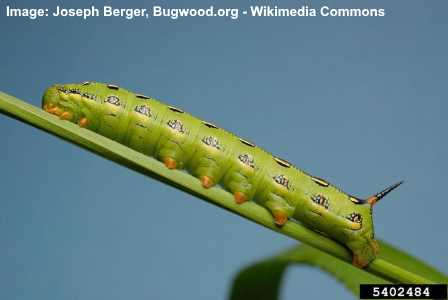
The White-lined Sphinx caterpillar has yellow and black markings on its bright green body with a horn on its back
The white-lined sphinx caterpillar is another type of ‘hornworm’ with a bright lime-green body. You will also notice black and yellow markings down its side.
This caterpillar species has a variety of colors. Some of the large fat caterpillars are black with stripes and some are green with orange or yellow spots. All these species have a horn at their tail. Although this makes the caterpillar look menacing, the horn doesn’t sting.
To identify the green white-lined sphinx caterpillar, look for rows of black spots with yellow centers on the side of each segment. Near the prolegs, you will notice a row of black and yellow dots with white specks.
Green Caterpillar Identification
To identify the White-lined Sphinx caterpillar look for the orange and black horn protruding from the back of this green caterpillar.
- Adult Stage: Develops into the white-lined sphinx moth
- Caterpillar Feeds on: Various plants, including members of the nightshade family (Solanaceae)
- Habitat: Found in a variety of habitats, including deserts, gardens, and open fields
- Stinging: Does not sting
- Rarity: Commonly seen in North and South America
Copper Underwing Moth Caterpillar (Amphipyra pyramidea)
The copper underwing caterpillar is a large, fat green caterpillar that looks like a type of hornworm. It has an almost translucent pale green body in its early stages. As it matures, the caterpillar’s segmented body becomes darker and develops a yellow stripe along its sides.
To help identify the copper underwing moth caterpillar, look for the large protruding bump at its rear. In mature caterpillars, there may be a colored horn-like tip on the end. This plump green caterpillar also has the characteristic of lifting the front part of its body when resting.
Look for four pairs of abdominal prolegs and three pairs of tiny frontal legs on this species of green caterpillar.
After emerging from the cocoon, this fat green caterpillar turns into the copper underwing moth with beautiful brown and bronze-colored wings.
Green Caterpillar Identification
A chubby-looking green caterpillar with an identifiable yellowish-white stripe along its sides, a pointed humped rear end, and a small rounded head.
- Adult Stage: Becomes a copper underwing moth
- Caterpillar Feeds on: Various deciduous trees and shrubs
- Habitat: Found in woodlands, gardens, and urban areas
- Stinging: Does not sting
- Rarity: Common and widespread in Europe and North America
Luna Moth Caterpillar (Actias luna)
The Luna moth caterpillar is a large caterpillar with a pale green body that can grow up to 3.5 inches (9 cm) in length. The lightly colored, green, ridged body features red or orange spots, some of which bear small, fine black spines. Unlike many green varieties that have smooth bodies, the Luna caterpillar’s segments are ridges.
The green Luna moth caterpillar is more of a spiky caterpillar rather than a hairy one. Although this caterpillar doesn’t sting, the sharp spikes could prick your skin and cause irritation.
Luna moth caterpillars from the Saturniidae family of insects are in the group of large silk moths.
Just before spinning a cocoon, the Luna moth caterpillar becomes a reddish-brown color.
Green Caterpillar Identification
The Luna moth is a caterpillar a large green caterpillar that can grow up to 3.5” (9 cm) in length. It is one of the more unusual green caterpillars that turn into elegant beautiful green moths.
- Adult Stage: Develops into the Luna moth
- Caterpillar Feeds on: Various broadleaf trees, including birch, sweetgum, and hickory
- Habitat: Found in forests and woodlands where host trees grow
- Stinging: Does not sting
- Rarity: Commonly found in eastern North America
Cabbage White Butterfly Caterpillar (Pieris rapae)
The cabbage white butterfly caterpillar is one of the most common caterpillar species. Their light green color means that these caterpillars are difficult to spot on cabbage, kale, or broccoli leaves.
One of the features of these caterpillars is their enormous appetite. The long green larvae continually feed to increase their size. The invasive nature of these caterpillars means they can be a pest for any gardener.
The way to identify the cabbage white caterpillars is by their green slender long body. You may notice that the caterpillars are green and yellow color due to lightly colored markings. The crawling caterpillar has a slight fuzziness to its appearance.
Some cabbage white caterpillars may have a bluish-green body with tiny black dots on the segments.
Green Caterpillar Identification
Immature cabbage white larvae have black heads that gradually turn yellow and then green during each growth stage.
- Adult Stage: Transforms into the cabbage white butterfly
- Caterpillar Feeds on: Various cruciferous plants, including cabbage, broccoli, and mustard
- Habitat: Found in gardens, agricultural areas, and open fields where host plants are cultivated
- Stinging: Does not sting
- Rarity: Common and widely distributed across North America and Europe
Hickory Horned Devil Moth Caterpillar (Citheronia regalis)
The hickory horned devil caterpillar is a giant bluish-green caterpillar with long spiky red horns with black tips. Each segment of the turquoise-green body has small black spikes. Either end of the caterpillar has red tips.
It is appropriately called a horned caterpillar and it is one of the scariest caterpillars you will find.
Despite its menacing look, this large species is one of the most placid in the Saturniidae family. The evil-looking caterpillar is harmless and it doesn’t sting or bite.
Green Caterpillar Identification
The Hickory Horned Devil caterpillar is one of the largest green caterpillars that can grow up to 6” (15 cm) long. This caterpillar can be as large as the palm of your hand.
- Adult Stage: Develops into the regal moth
- Caterpillar Feeds on: Various deciduous trees, including hickory, walnut, and ash
- Habitat: Found in woodlands and forested areas where host trees grow
- Stinging: Does not sting
- Rarity: Not considered rare and is found in parts of North America
Rustic Sphinx Moth Caterpillar (Manduca rustica)
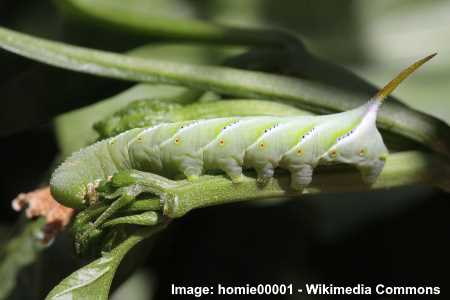
The Rustic Sphinx caterpillar is a green caterpillar that has a large horn and white stripes on its body
The rustic sphinx caterpillar is a large green caterpillar, growing to lengths of up to 3.5 to 4 inches (9 to 10 centimeters). This horned caterpillar can be identified by its lime green body, which features distinctive diagonal white and maroon stripes on its sides. It has a large, spiky horn at the rear, which is non-stinging.
Some species of this large fat caterpillar have a reddish coloring on the top. Diagonal white strips divide this color from the green color on the lower segments. Their horny tails can be yellow with red freckling.
The name of these ‘sphinx’ caterpillars comes from the way they like to raise the front of their body up like the Sphinx in Egypt.
The Rustic Sphinx caterpillar is generally found in states such as Texas, Florida, South Carolina, and Mississippi.
Green Caterpillar Identification
The Rustic Sphinx caterpillar (Manduca rustica) is a large bulky looking green species of caterpillar with diagonal white stripes and large horn.
- Adult Stage: Transforms into the rustic sphinx moth
- Caterpillar Feeds on: Various plants, including members of the nightshade family (Solanaceae)
- Habitat: Found in a variety of habitats, including gardens and open areas
- Stinging: Does not sting
- Rarity: Commonly seen in North and South America
European Puss Moth Caterpillar (Cerura vinula)
The European puss caterpillar is a fat lime-green caterpillar. This unusual looking large caterpillar has a triangular head at one end and long spiked tails at the other.
When under threat, the caterpillar extends red menacing lashes to ward off other insects. Also, the head end of the caterpillar has patterning that resembles a scary face. This looks like a mouth wide open bearing gnashing teeth.
This European Puss is one of the more dangerous caterpillars on this list. If you happen to identify one, you should stay clear of it. When annoyed, the European Puss caterpillar can spit poisonous acid. You can tell when the caterpillar is agitated because it will raise up its head and whip its long tails from side to side.
This unique green ‘pus’ caterpillar should not be confused with the American Puss caterpillar that is a hairy variety.
Green Caterpillar Identification
A big plump green caterpillar that can grow up to 3” (8 cm) and act aggressively.
- Adult Stage: Develops into the puss moth
- Caterpillar Feeds on: Various deciduous trees, including willow, poplar, and birch
- Habitat: Found in woodlands and wooded areas where host trees grow
- Stinging: Does not sting
- Rarity: Common in parts of Europe and Asia
Cecropia Moth Caterpillar (Hyalophora cecropia)
The Cecropia moth caterpillar is one of the largest and unique-looking green caterpillars you will come across. The larvae start off as a yellowish-green color before becoming bluish-green in later stages.
The large segments on the Cecropia moth caterpillar give it a ridged appearance. One of the unique identifying features of the giant green Cecropia moth caterpillar are the yellow, blue, or orange tubercles that grow on the body. Each of these colorful bumps sprouts small black spikes. There are even blue tubercles on the prolegs on its middle section.
Although this may be one of the most bizarre-looking caterpillars you will see, they turn into some of the most beautiful moths. In fact, the Cecropia moth that comes from this caterpillar is one of the largest moths in North America.
Green Caterpillar Identification
The Cecropia moth caterpillar is a giant green caterpillar, and it can grow up to a length of 4.5” (10 cm).
- Adult Stage: Transforms into the cecropia moth
- Caterpillar Feeds on: Various deciduous trees and shrubs, including maple, birch, and cherry
- Habitat: Found in woodlands and forested areas where host plants grow
- Stinging: Does not sting
- Rarity: Common in parts of North America
Hackberry Emperor Caterpillar (Asterocampa celtis)
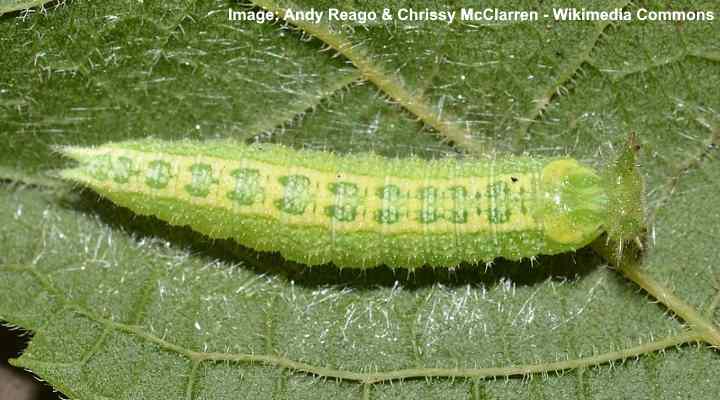
The hackberry emperor caterpillar is pale green with yellowish stripe along its body and a split tail at its rear
The hackberry emperor caterpillar is a light green caterpillar with two thin yellowish stripes running the length of its body. To help identify the hackberry emperor caterpillar, look for numerous tiny yellow raised dots covering the body, a dark green head with two small horns, and two sharp tails at its rear.
Hackberry emperor larvae grow up to 1.5” (4 cm) long. Their light green color and tiny yellowish bumps covering the body can make them difficult to spot on hackberry trees.
As its name suggests, you will often find hackberry emperor caterpillars on hackberry trees. In late fall, green hackberry emperor caterpillars turn brown and overwinter inside curled hackberry tree leaves. The crawling worm-like insects emerge in spring and start to feed on hackberry leaves and leaf buds.
After emerging from the pupa, the hackberry emperor caterpillar is a stunning brown butterfly with white, brown, and black markings on its wings.
Green Caterpillar Identification
The plump green caterpillar with its darker head is covered in pale yellow raised bumps, and there are two dotted lines from head to the rear and two spiked tails.
- Adult Stage: Develops into the hackberry emperor butterfly
- Caterpillar Feeds on: Various host plants, including hackberry (Celtis species)
- Habitat: Found in a range of habitats, including woodlands and open areas where hackberry trees grow
- Stinging: Does not sting
- Rarity: Not considered rare and is found in parts of North America
Green Cloverworm (Hypena scabra)
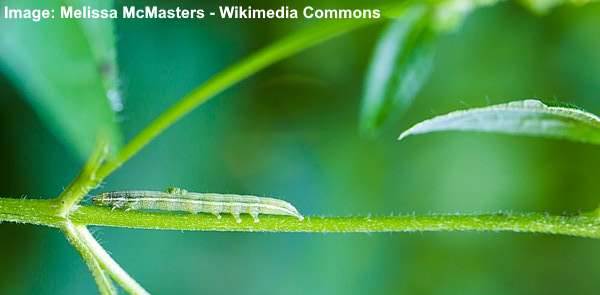
The green cloverworm caterpillar can be identified by its 3 pairs of abdominal prolegs and whitish stripe along the side of its body
The green cloverworm caterpillar is identified by its yellowish-green head, thin yellow lines wrapping around the body, and pale greenish-white stripe along its sides. Another way to recognize this green caterpillar is by its three pairs of abdominal prolegs and a pair at its rear.
Green cloverworms have the characteristic of squirming when disturbed. This unique behavior looks like they jump and then flop.
Also called black snout, green cloverworm caterpillars measure between 1” and 1.2” (2.5 – 3 cm) long. They are destructive caterpillars that feed on soybeans and other legumes.
After the pupal stage, green clover worms turn into a dark brown moth with triangular wings.
Green Caterpillar Identification
Green caterpillars with segmented bodies separated by thin yellow lines. Look for the identifiable white stripe running along each side.
- Adult Stage: Transforms into the green cloverworm moth
- Caterpillar Feeds on: A wide range of broadleaved plants, including many common weeds
- Habitat: Can be found in various habitats where host plants grow
- Stinging: Does not sting
- Rarity: Not considered rare and is found in parts of North America
Diamondback Moth Caterpillar (Plutella xylostella)
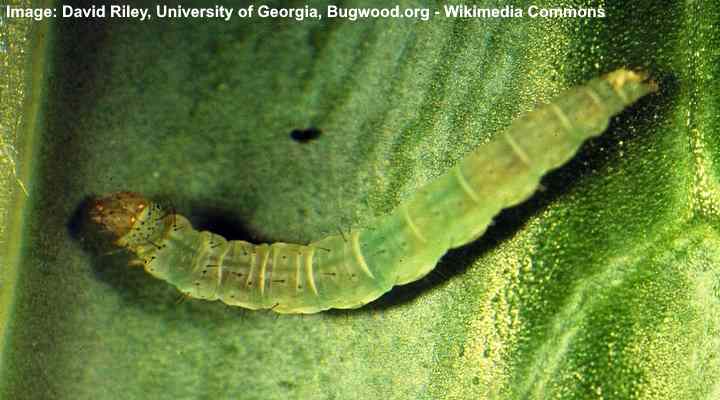
The small pale green diamondback caterpillar has V-shaped rear, darker head and tiny black hairs on its body
The diamondback moth caterpillar is a small, pale green caterpillar with black spiny hairs on its body, small white dots, a brown to black head, and a tapering rear. An identifying feature of the diamondback moth caterpillar is the five pairs of prolegs, one of which forms a distinctive V shape at its rear.
Also called cabbage moth caterpillar, the tiny green wriggling larvae measure up to 0.4” (1 cm). This caterpillar changes color as it matures. The diamondback caterpillar emerges almost colorless from the egg and gradually develops a green body and black head. As the caterpillar grows, its head becomes green or brown.
In its first instar, the diamondback moth is a type of leaf miner that lives inside leaves, feeding on leaf tissue. After emerging from leaves, the tiny green caterpillars munch through the underside of leaves. This feeding habit means that small green diamondback moth caterpillar damage on cabbages, broccoli, and cauliflowers can go undetected for some time.
Green Caterpillar Identification
Look for the short black hairs emerging from whitish patches, V-shaped rear, and dark head on this tiny green caterpillar.
- Adult Stage: Develops into the small diamondback moth
- Caterpillar Feeds on: Various cruciferous plants, including cabbage and broccoli
- Habitat: Found in agricultural fields and gardens
- Stinging: Does not sting
- Rarity: Common and found worldwide
Io Moth Caterpillar (Automeris io)
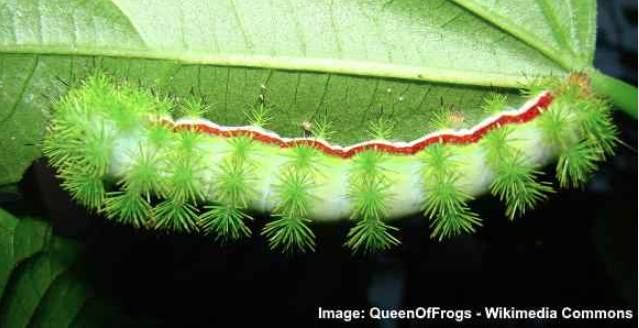
The Io moth caterpillar has green spikes that feel very unpleasant if their venom penetrates your skin
Io moth caterpillars emerge from the eggs a rusty-brown color with thin black stinging hairs. They gradually turn green and develop the characteristic stinging needle-like green tufts that look like pine needles.
You can identify the Io moth caterpillar by its red and white stripes running the length of its side. Green spikes stick out from all parts of its body. There are even tiny spikes on the 4 pairs of prolegs on its central segments.
Io moth caterpillars grow up to 2.3” (6 cm) long.
The spines of io moth caterpillar contain toxic substances that cause a lot of skin irritation. The urticating spines can give you a nasty “bite” if the venom gets into your skin. Even the slightest touch of these stinging venomous caterpillars can cause a lot of pain that lasts an hour or so.
After metamorphosis, the fat, fuzzy green Io moth caterpillars turn into spectacular orange or yellow moths with huge eye markings on the wings.
Green Caterpillar Identification
To identify the Io moth caterpillar look for the recognizable tufts of stinging green spines covering the fat, lime-green body with red and white stripes running along its sides.
- Adult Stage: Transforms into the io moth
- Caterpillar Feeds on: Various plants, including oak, willow, and cherry
- Habitat: Found in woodlands, gardens, and open areas
- Stinging: May deliver a painful sting if handled
- Rarity: Common in parts of North America
Rough Prominent Moth (Nadata gibbosa)
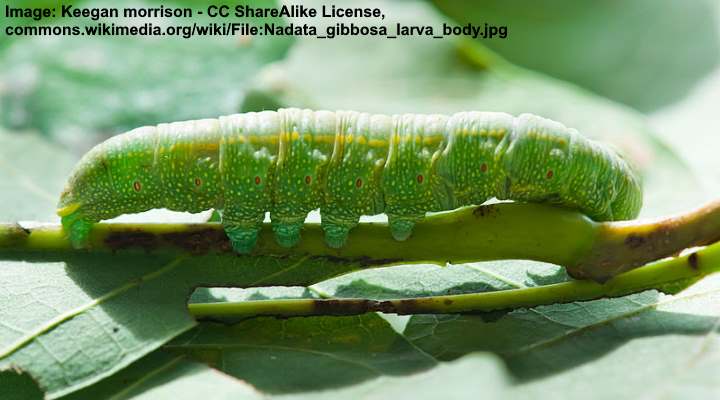
The plump rough prominent caterpillar has yellow specks and lines along its green segmented body
The rough prominent moth caterpillar is a pale green to turquoise, plump caterpillar with a large, rounded head and small black, eye-like markings. The identifying characteristics of this caterpillar include numerous yellowish speckles, a red circular dot on the side of each segment, and pale-yellow stripes on the sides.
The pale-green, yellow-striped caterpillar has a ball-like translucent green head, and the caterpillar matures at 0.7” (1.7 cm) long.
The rough prominent caterpillar also has names such as white-dotted prominent and green oak caterpillar.
You will often find the green rough prominent caterpillar munching on oak leaves, as well as foliage on birch, alder, maple, cherry, and willow trees.
Green Caterpillar Identification
Identify the rough prominent caterpillar by its smooth, fat, green segmented body with yellow speckled markings. It has a yellowish mid-dorsal line, and a line of red dots near the abdomen.
- Adult Stage: Develops into the rough prominent moth
- Caterpillar Feeds on: Various deciduous trees and shrubs
- Habitat: Found in woodlands and forested areas where host plants grow
- Stinging: Does not sting
- Rarity: Not considered rare and is found in parts of North America
Cloudless Sulphur Butterfly (Phoebis sennae)
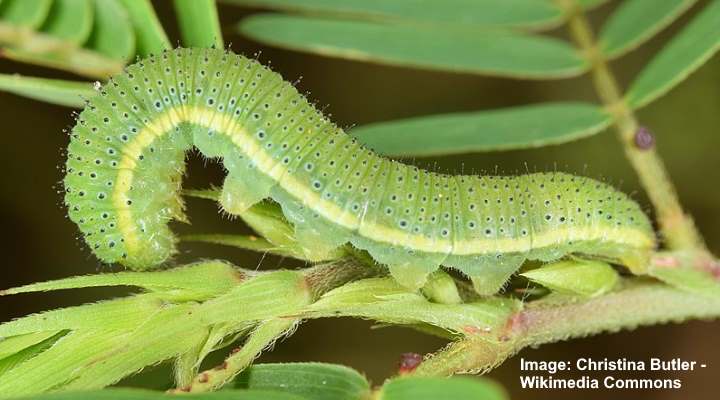
The cloudless sulphur caterpillar has a yellow line on the side of its green body with tiny blue-black dots
The cloudless sulphur caterpillar is a green caterpillar with yellow stripes and blue or black dots. The bluish-black spots are in rows across the center of the segments. There are also tiny black setae—groups of bristle-like hairs on its body. Some species of cloudless sulphur caterpillar are a yellowish-green color.
An unusual feature of Phoebis sennae is that the caterpillar’s color depends on what it feeds on. Green cloudless sulphur caterpillars get their color from feeding on green foliage. However, the yellow type of caterpillar occurs when the fat caterpillars feed on yellow petals.
Cloudless sulphur caterpillars grow between 1.6” and 1.8” (4 – 4.5 cm) long.
Green Caterpillar Identification
Identifying characteristics of cloudless sulphur caterpillar are its green body, and a lateral yellow stripe on each side. It has rows of blue and black dots, and tiny bristles on its abdomen and feet.
- Adult Stage: Transforms into the cloudless sulphur butterfly
- Caterpillar Feeds on: Various plants, primarily members of the legume family (Fabaceae)
- Habitat: Found in open areas, gardens, and fields
- Stinging: Does not sting
- Rarity: Common and widely distributed in the Americas
Crowned Slug caterpillar (Isa textula)

The crowned slug caterpillar has a distinctive look with stinging spines around the sides of its green flat body
The crowned slug caterpillar is one of the most unusual pale-green caterpillars. The crawling insect is easy to identify by its flattened oval body which has stinging hairs sticking out from its sides. Other identifying marks are the two lines on its back, horns, and two spiked tails.
This slug caterpillar looks more like a fuzzy spherical leaf. Even though it looks flat, it has a ridged back with two pale yellow lines. There are a pair of horns on one end and plumes of stinging green spins on the other. The stinging green, yellow, or red spiny protrusions radiate around its body make it easy to identify.
The crowned slug caterpillar grows up to 0.6” (1.5 cm) long. Although the crowned slug caterpillar looks stunning, it can give you a nasty sting if you touch it.
Green Caterpillar Identification
Identify the crowned slug caterpillar by its oval pastel green body and plumes of stinging hairs around its side. It also has a pair of orange-red horns, and two yellow stripes on its back.
- Adult Stage: Develops into the crowned slug moth
- Caterpillar Feeds on: Various deciduous trees and shrubs
- Habitat: Found in woodlands and gardens
- Stinging: Does not sting
- Rarity: Found in North America from Minnesota, southern Ontario and Massachusetts to Florida, Texas, and Mississippi
Oak Slug caterpillar (Euclea delphinii)

The oak slug caterpillar has an unusual colorful look with venomous spikes all over its body and 2 lines of orange stripes
The oak slug caterpillar is a green oval caterpillar with plumes of stinging spikes, orange lines, and black and white ring-like markings. It’s easy to identify this slug caterpillar by the orange or yellow fuzzy spikes pointing out its back, ends, and sides.
The ovoid-shaped lime green body is divided into three lateral sections by two rows of orange spines. Look for recognizable circular patterns with black and white rings on its green back.
The bright colors of the oak slug caterpillar are warning signs to stay away. You will often find oak slug caterpillars in deciduous woodlands and forests. After the pupal stage, the spiky caterpillar emerges as a small brown hairy moth.
The spiny oak slug caterpillar grows up to 0.8” (2 cm) long.
Green Caterpillar Identification
The spiny oak slug caterpillar has a green elongated oval body, two orange stripes on its back, black circular patterns, and plumes of venomous spines.
- Adult Stage: Transforms into a moth in the family Limacodidae
- Caterpillar Feeds on: Various deciduous trees
- Habitat: Found in woodlands and gardens
- Stinging: Does not sting
- Rarity: East of central Texas and north of Oklahoma
Fall Webworm (Hyphantria cunea)
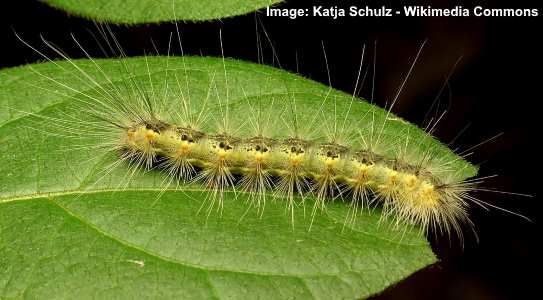
The fall webworm is a type of a small yellowish-green hairy caterpillar with long spikes
The fall webworm caterpillar is a yellowish-green caterpillar with tufts of long, thin hair-like spines. The furry caterpillar has rows of yellow spines sticking out from all parts of its body. You will also notice rows of round black dots along the back.
Fall webworms can come in a wide range of colors. Some of these small fuzzy caterpillars can be pale yellow with black dots, and others can be dark gray with light markings.
These thin fuzzy fall webworm caterpillars measure up to 1” (2.5 cm) long. These hairy caterpillars love to munch their way through leaves on walnut, cherry, crabapple, and other deciduous trees.
The name webworm comes from the unusual habit of these caterpillars to spin large tent-like structures around host plants.
The color of fall webworm caterpillars comes from their habitat. Green-bodied fall webworms tend to be found in warmer climates. In contrast, the dark furry caterpillars live in colder, northern climates. Therefore, noticing web-like tents on branch tips is a way to recognize webworm infestations on trees.
Green Caterpillar Identification
The fall webworm is identified by extremely long yellow or white hairs growing from orange-red tubercles all over its body.
- Adult Stage: Develops into a white moth
- Caterpillar Feeds on: Various deciduous trees, including walnut and cherry
- Habitat: Found in woodlands and gardens
- Stinging: Does not sting
- Rarity: Common in North America, ranging from Canada to Mexico, as well as Europe and parts of Asia
Spicebush Swallowtail Caterpillar (Papilio Troilus)
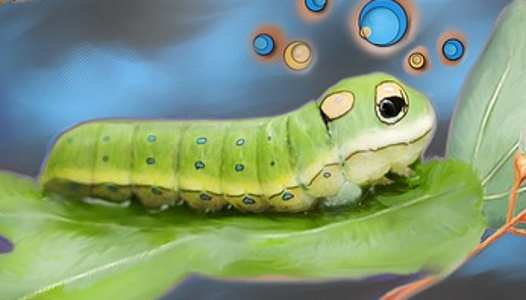
The spicebush swallowtail caterpillar has markings that look like fake eyes on its head
The spicebush swallowtail is a fat green to yellow caterpillar with bands of bluish-green dots around its segments. Its head has eye-like black and white markings, giving the spicebush swallowtail caterpillar the appearance of a comical snake.
Green spicebush swallowtail caterpillars grow between 2.5” and 3.8” (6 – 9.5 cm) long. They have a relatively plump body. During the early stages of growth, the caterpillars are brown with white markings that look like bird droppings. As they mature, they become pale green and develop burgundy or brown undersides.
One of the fascinating characteristics of the spicebush swallowtail is the false eyespots on its head that offer protection from predators. These have a black pupil on a yellowish oval circle and a white “reflection” spot.
If the spicebush swallowtail caterpillar feels threatened, it will rear up and emit a foul-smelling odor to ward off birds and other insects. It may be difficult to spot this caterpillar as it usually feeds at night and hides during the day.
Green Caterpillar Identification
Identify the Spicebush swallowtail caterpillar by its two false eyespots on its head, pale green body, and small blue and black dots in a transverse band.
- Adult Stage: Transforms into the spicebush swallowtail butterfly
- Caterpillar Feeds on: Spicebush and sassafras plants
- Habitat: Found in woodlands, gardens, and wetlands where host plants grow
- Stinging: Does not sting
- Rarity: Commonly found in parts of North America
Tobacco Hornworm Caterpillar (Manduca sexta)

The large green tobacco hornworm caterpillar has seven white diagonal lines with a black dots
The tobacco hornworm caterpillar is a large, fat green caterpillar with diagonal white stripes with black dots. It has a row of black and yellow dots along the side, and a horn at its rear that can be green, orange or brown. Although this caterpillar is harmless to humans, it can damage crops like tomato plants and other plants in the nightshade family.
Tobacco hornworms and tomato hornworm caterpillars look alike. However, the plump tobacco hornworm is slightly smaller, measuring up to 2.7” (7 cm).
To tell the difference between the two types of hornworms, look at the markings. For example, tobacco hornworms have seven white diagonal lines with a black border. But tomato hornworms have eight V-shaped borderless markings and a black horn.
Green Caterpillar Identification
You can spot a tobacco hornworm caterpillar by its diagonal white and black striped markings, tiny black dots with a white ring, and orange or brownish-red horn-like protrusion on its tail.
- Adult Stage: Becomes the Carolina sphinx moth
- Caterpillar Feeds on: Tobacco, tomato, and other plants in the nightshade family (Solanaceae)
- Habitat: Found in gardens and agricultural fields
- Stinging: Does not sting
- Rarity: Common in North America
Cross-Striped Cabbage Worm (Evergestis rimosalis)
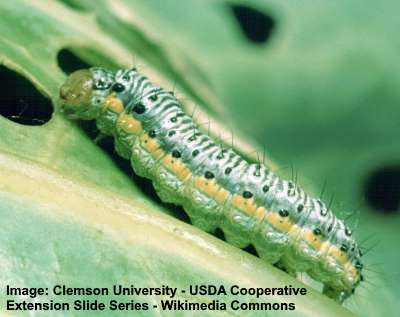
The cross-striped cabbage worm has green body, white marks on the back and yellow stripe on each side
The cross-striped cabbage worm is a striped, green caterpillar with a yellow band and dark green dots. It has zebra-like markings, fine hairs, and a round brown head. The caterpillar is one of the most colorful of the green caterpillars. As the caterpillar matures, the green coloring darkens to deep blue or black.
Although called a worm, the cross-striped cabbage worm is a caterpillar in the insect order Lepidoptera. The stunning fat green caterpillars turn into tan-colored moths.
Cross-striped cabbage worms grow between 0.4” and 0.6” (1 – 1.5 cm) long.
Green Caterpillar Identification
Identify the green cross-striped cabbage caterpillars by their distinctive yellow line along their sides. They also have black dots on the segments, and black and white markings on the greenish-white back.
- Adult Stage: Develops into a small moth
- Caterpillar Feeds on: Various cruciferous plants, including cabbage and broccoli
- Habitat: Found in gardens and agricultural areas
- Stinging: Does not sting
- Rarity: Common in most of the eastern United States
Rosy Maple caterpillar (Dryocampa rubicunda)

The light green striped rosy maple caterpillar has black dots and 2 black horns poking out from its head
The rosy maple caterpillar is a striped, bright green caterpillar with a brown head, bands of black dots, and a pair of black antennae. As the fat green caterpillar matures, it changes in appearance. The rosy maple caterpillar develops black spines, the bulbous brown head darkens, and white, green, or black stripes develop along its length.
Rosy maple caterpillars grow up to 2” (5 cm) long and can have a plump green, striped body when mature. The caterpillars also go by the name green-striped mapleworm.
After the pupal stage, the bright green caterpillar emerges from the cocoon as one of the most colorful furry moths. The rosy maple moth has bright pink and white fuzzy wings with a yellow head and pink antennae.
Green Caterpillar Identification
Identification marks of the rosy maple caterpillar are a bright green body, darker longitudinal stripes, two black horns, a black abdomen, and red or pink streaks at its rear.
- Adult Stage: Transforms into the rosy maple moth
- Caterpillar Feeds on: Maple tree leaves, particularly those of the red maple
- Habitat: Found in woodlands and gardens where maple trees grow
- Stinging: Does not sting
- Rarity: Commonly seen in parts of North America
Dragon-Headed Caterpillar (Polyura athamas)
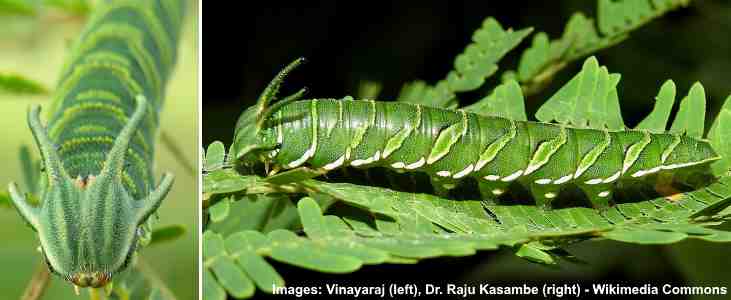
The green dragon-headed caterpillar has 4 horns on its head and white markings (stripes) on its sides
The dragon-headed caterpillar is a long, dark-green slug-like caterpillar with a large head, four scary-looking horns, whitish-yellow lateral stripes, and small white spots. Despite its menacing appearance, the dragon-headed caterpillar is harmless. The tropical caterpillar tends to feed on leguminous plants.
Looking at pictures of the green dragon-headed caterpillar, it’s easy to see how Polyura athamas gets its common name. The green caterpillar head looks like a mythical dragon with its two long central spiky “horns” and two shorter peripheral stumpy horns emerging from its flat head.
You’ll also notice that the dragon-headed caterpillar has four pairs of prolegs, each with a white marking. There is also a line of white markings along the base of each segment. Looking at the caterpillar from above, you’ll notice its markings are in the shape of a V.
Green Caterpillar Identification
The main identifying characteristic of the dragon-headed caterpillar is its four impressive long horns. Additionally, prominent diagonal white stripes and white markings along the side help to identify this green caterpillar.
- Adult Stage: Develops into the dragon-headed butterfly
- Caterpillar Feeds on: Leaves of various plants in the bean family (Fabaceae)
- Habitat: Found in woodlands and open areas
- Stinging: Does not sting
- Rarity: Not considered rare, found in parts of Asia
Angle Shades Moth Caterpillar (Phlogophora meticulosa)
The angle shades caterpillars in the Noctuidae family are small larvae in comparison to some huge species. These caterpillars can be dull green with whitish dorsal lines. Others are green or brown with red spots along their sides.
Green Caterpillar Identification
This caterpillar has a green body with a pale dotted line along its side and narrow yellowish bands separating its segments. Sometimes the caterpillars can be pinkish brown.
- Adult Stage: Transforms into the angle shades moth
- Caterpillar Feeds on: Various herbaceous plants
- Habitat: Found in a wide range of habitats, including gardens and woodlands
- Stinging: Does not sting
- Rarity: Common and widely distributed in Europe
Cabbage Looper Caterpillars (Trichoplusia ni)
Cabbage looper caterpillars get their name from the way they crawl, making large arching actions. These cabbage worms are slightly hairy due to fine bristles that grow on their bodies. As they mature, they take on a green color and grow up to 1.5” (4 cm). Also, their feeding habits increase until they are eating 3 times their body weight daily.
Green Caterpillar Identification
The cabbage looper caterpillar is identified by its pale, lime green color, white stripe along its side, and sparsely covered by fine hairs. The green caterpillar also has a distinctive looping habit when it moves.
- Adult Stage: Develops into a medium-sized moth
- Caterpillar Feeds on: Various crops and plants, including cabbage, lettuce, and beans
- Habitat: Found in agricultural fields and gardens
- Stinging: Does not sting
- Rarity: Common in North America and Eurasia
Imperial Moth Caterpillar (Eacles imperialis)
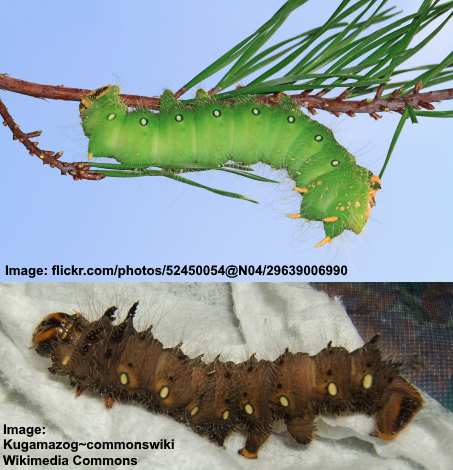
The large Imperial moth caterpillar can greatly vary in color. Most mature ones are brown, maroon or green
There are a number of subspecies in the Imperial moth caterpillar species. Imperial moth caterpillars aren’t a poisonous type of caterpillar but they can do a lot of damage to crops. Some species of these large caterpillars are green and yellow and others are brown and burgundy. The fat green ones can grow to a huge size of 5.5” (10 cm).
Green Caterpillar Identification
The imperial moth caterpillar is a fat green larva, identified by a row of yellow dots along its side and yellowish spiny horns at its head and tail end.
- Adult Stage: Transforms into the imperial moth
- Caterpillar Feeds on: Leaves of various deciduous trees, including oak and maple
- Habitat: Found in woodlands and gardens where host trees grow
- Stinging: Does not sting
- Rarity: Commonly seen in parts of North America
Long-Tailed Skipper Caterpillar (Urbanus proteus)
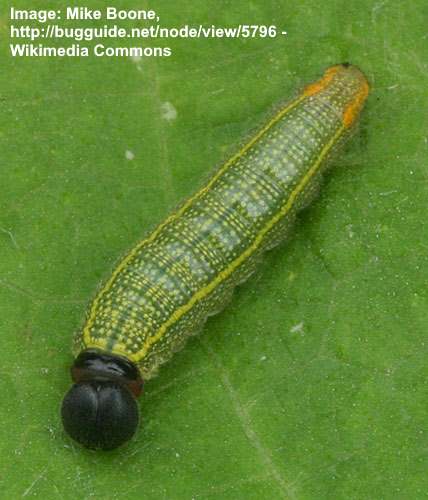
The long-tailed skipper caterpillar has a green body with yellow dots and lines and dark rounded head
The long-tailed skipper caterpillar is a large green caterpillar with a distinctive rounded brownish-black head and is covered in yellowish dots. Other identifying marks of this cigar-shaped larva are thin yellow lines along its back, two orange markings at its tail end, and orange prolegs.
This slug-like caterpillar is common in Florida, feeding on legumes and ornamental plants in the bean family. Its unusual habit of rolling leaves around itself earned it the common name bean leafroller.
Green Caterpillar Identification
Identifying features of the long-tailed skipper caterpillar are its green body with bands of yellowish dots and yellow lines running its length. However, its most distinguishing feature is its ball-like dark head.
- Adult Stage: Develops into the long-tailed skipper butterfly
- Caterpillar Feeds on: Leguminous plants, including beans and peas
- Habitat: Found in open areas, gardens, and fields
- Stinging: Does not sting
- Rarity: Common in parts of North and South America
Forester Moth Caterpillar (Zygaenidae)
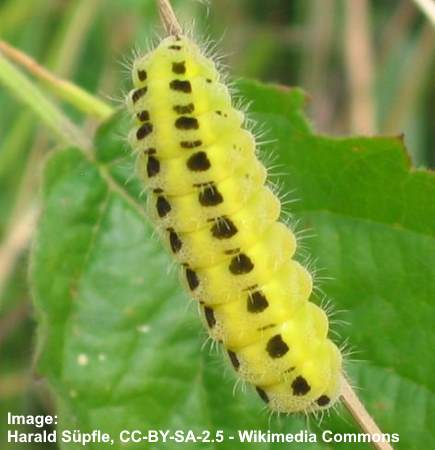
The forester moth caterpillar is identified by its yellowish-green body with rows of black dots
The forester moth caterpillar has a distinctive yellowish-green color. It is identified by two rows of black spots running along its back and spiky tufts. The plump, stout caterpillar has a segmented body and measures around 4.7” (12.5 cm) before it pupates. Its bright chartreuse color helps to ward off predators.
Forester moth caterpillars feed on herbaceous plants in the warm subtropical regions in the southern United States. The brightly-colored caterpillar turns into a spectacular black and white moth after pupation and is sometimes called a smoky moth.
Green Caterpillar Identification
The yellowish-green forester moth caterpillar is a slug-like caterpillar with black dots and spiny tufts of hairs on its body. The larva has a distinctive flattened body.
- Adult Stage: Develops into various moth species within the Zygaenidae family
- Caterpillar Feeds on: Various plants, depending on the specific species
- Habitat: Found in a variety of habitats, including woodlands and grasslands
- Stinging: Some species in this family may possess stinging hairs
- Rarity: Varies among different Zygaenidae species
Polyphemus Moth Caterpillar (Antheraea polyphemus)

The polyphemus moth caterpillar has red dots along his lime-green body
The polyphemus moth caterpillar is a lime-green colored caterpillar with distinct bands of bright red dots traversing its body. Each of the neon-red dots has a long setae, giving the green caterpillar a slightly hairy appearance. The stout caterpillars measure 3” to 4” (7.5 – 10 cm) long.
The polyphemus moth caterpillar looks different through its various instars. The young caterpillars have black and white stripes around their abdomen and are covered in orange tubercles sprouting short black hairs. When the caterpillar pupates, it’s a large, dark green larva, sometimes with yellowish lines on its sides.
Green Caterpillar Identification
The polyphemus moth caterpillar is identified by reddish bumps around its lime-green to dark green body.
- Adult Stage: Transforms into the polyphemus moth
- Caterpillar Feeds on: Leaves of various deciduous trees, including oak and maple
- Habitat: Found in woodlands and gardens where host trees grow
- Stinging: Does not sting
- Rarity: Commonly found in parts of North America
Common Pine Sawfly (Diprion pini)
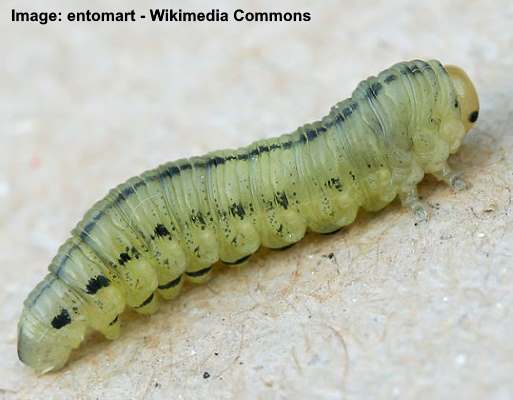
The common pine sawfly larva has a pale green body with black line and black spots
The common pine sawfly larva is a pale green bug with a black line along its back and a band of black spots along its sides. The easily recognizable larva develops a rounded orange head with black dots as it matures.
The small caterpillar-like larva grows up to 0.4” (1 cm) long. In its larval stage, Diprion pini can do tremendous damage to pine trees.
It’s worth noting that this sawfly larva isn’t a caterpillar from the moth or butterfly order Lepidoptera. Instead, after pupation, it turns into a brown-winged insect called the common pine sawfly.
Green Caterpillar Identification
The larva of the common pine sawfly is an easily identifiable caterpillar-like bug with a pale green body and black bands running the length of its body.
- Adult Stage: Develops into a sawfly species
- Caterpillar Feeds on: Pine needles and foliage
- Habitat: Found in coniferous forests with pine trees
- Stinging: Does not sting
- Rarity: Commonly encountered in coniferous forested regions throughout Europe and Russia
Eumorpha Sphinx Caterpillar (Eumorpha fasciatus)
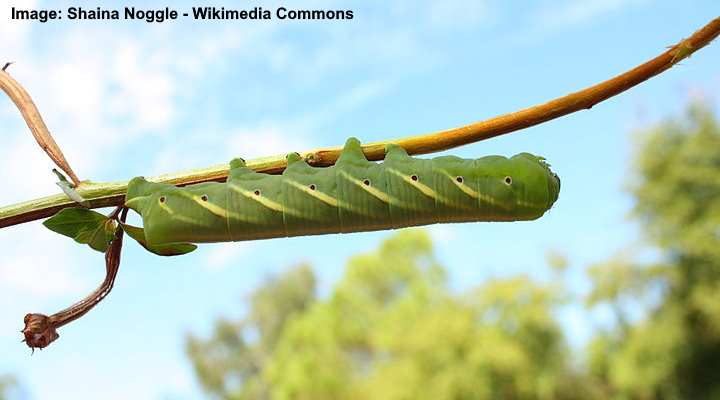
The large eumorpha sphinx caterpillar is green with yellow diagonal lines and black dots but can have color variations
The eumorpha sphinx caterpillar is an unusual green caterpillar because it has many color variations. The large larva has a row of black dots along its side, diagonal yellowish-white stripes, and a spiked tail. However, the caterpillar can also be yellowish-green with red bands and yellow and white stripes.
Also called the banded sphinx caterpillar, you’ll often find the larvae feeding on plants in the Oenothera (evening primrose) or Ludwigia species.
Green Caterpillar Identification
The eumorpha sphinx caterpillar is challenging to identify because of its color variations. For example, the green caterpillar can have yellow, black, red, white, or orange stripes. In addition, some instars of the caterpillar resemble the tobacco hornworm.
- Adult Stage: Transforms into a sphinx moth within the Eumorpha genus
- Caterpillar Feeds on: Leaves of various plants, including grapevines
- Habitat: Found in gardens, woodlands, and vineyards
- Stinging: Does not sting
- Rarity: Common in parts of South America, Central America, and parts of USA
Honey Locust Moth Caterpillar (Syssphinx bicolor)
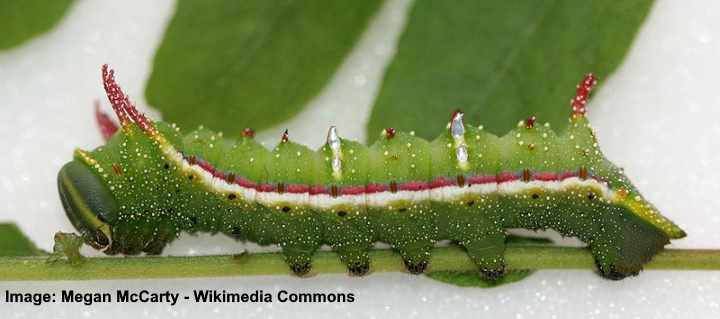
The honey locust caterpillar is identified by its green body with white dots, red and white line along its sides and two red horns
The honey locust moth larva is a green caterpillar with white speckled tubercles. The green caterpillar is identified by its two pairs of reddish horns, whitish spiny hairs, and a white and red stripe along its sides. Its unusually looking head has yellow bands on its face.
The green honey locust caterpillar has a stout body that grows 1.5” (3.8 cm) long. You’ll find the leaf-destroying larvae feeding on honey locust and Kentucky coffee trees.
Green Caterpillar Identification
The honey locust moth caterpillar has a dark green abdomen, a pair of fleshy red horns at either end, a white and red abdominal band, and is covered in white speckles.
- Adult Stage: Develops into the honey locust moth
- Caterpillar Feeds on: Leaves of honey locust trees
- Habitat: Found in woodlands and areas with honey locust trees
- Stinging: Does not sting
- Rarity: Not considered rare in regions in North America where honey locust trees grow
Northern Pearly-Eye Caterpillar (Enodia anthedon)

The pale green northern pearly-eye caterpillar is covered with tiny yellowish dots and has a pale pink horns
The northern pearly-eye butterfly larva is a pale green caterpillar with pinkish horns, rows of brightly-colored yellow dots, and covered in fine setae. This green larva has an identifiable pointed tail end and an oval head. This yellowish-green caterpillar grows 1.77” (4.5 cm).
The pale green caterpillars are found feeding on various types of grass. After pupation, the caterpillar turns into an attractive brown butterfly with identifiable brown eyespots on its wings.
Green Caterpillar Identification
The northern pearly-eye caterpillar is an easily identifiable caterpillar with pale reddish-pink horns and a pointed rear. It is covered in tiny yellowish speckles and fine hairs.
- Adult Stage: Transforms into the northern pearly-eye butterfly
- Caterpillar Feeds on: Grasses, sedges, and other herbaceous plants
- Habitat: Found in grassy habitats, including woodlands and meadows
- Stinging: Does not sting
- Rarity: Commonly found in North America
Orange-Barred Sulphur Caterpillar (Phoebis philea)

The pale green and black striped orange-barred sulphur caterpillar has small black bumps along its body
The orange-barred sulphur caterpillar is a pale yellow-green caterpillar. It has two black longitudinal stripes along its back and it is covered in small fleshy bumps. This black and green striped caterpillar is typically found munching on foliage on clover and legume plants.
The color of the orange-barred sulphur caterpillar depends on the type of plants it consumes. For example, eating dark green leaves makes the caterpillar a darker color. However, if it eats yellowish leaves, the caterpillar will be a pale green to yellow color.
Green Caterpillar Identification
The caterpillar of the orange-barred sulphur butterfly is a yellowish-green larva with broad black bands running from head to tail. The striped caterpillar is also covered in stumpy fleshy black spines.
- Adult Stage: Develops into the orange-barred sulphur butterfly
- Caterpillar Feeds on: Leaves of plants in the legume family (Fabaceae)
- Habitat: Found in various open habitats, including gardens and fields
- Stinging: Does not sting
- Rarity: Commonly seen in parts of the Americas
Silver-Spotted Skipper Caterpillar (Epargyreus clarus)
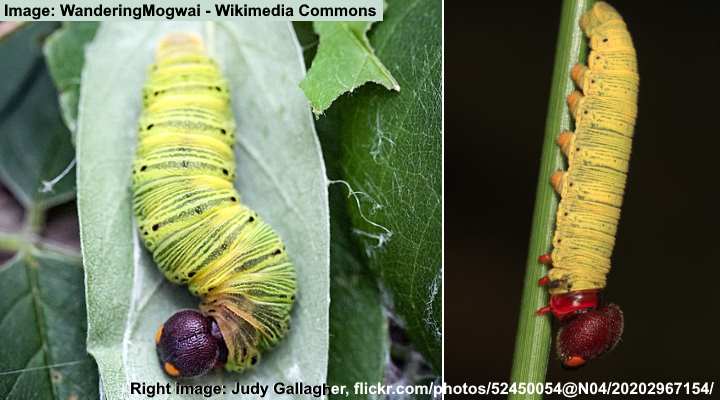
The silver-spotted skipper is a yellow-green caterpillar with brown rounded head and two orange eyespots
The silver-spotted skipper caterpillar is an unusual yellowish-green caterpillar with a dark brown ball-like head and thin lateral stripes on its abdomen. Other identifying features of the green caterpillar are its orange eyespots, three pairs of red forelegs, and eight orange prolegs. It also has a reddish-brown band behind its head.
This striped caterpillar measures 2” (5 cm) long. The silver-spotted skipper caterpillar feeds on leaves of shrubs, herbs, vines, and plants in the pea family Fabaceae.
Green Caterpillar Identification
The silver-spotted skipper larva is a plump, slug-like yellowish-green caterpillar with thin traversing stripes, orange legs, and a reddish-brown head.
- Adult Stage: Transforms into the silver-spotted skipper butterfly
- Caterpillar Feeds on: Leaves of leguminous plants, including beans and peas
- Habitat: Found in open areas, gardens, and fields
- Stinging: Does not sting
- Rarity: Common and widely distributed in North America
Copper Underwing Moth Caterpillar (Amphipyra pyramidoides)
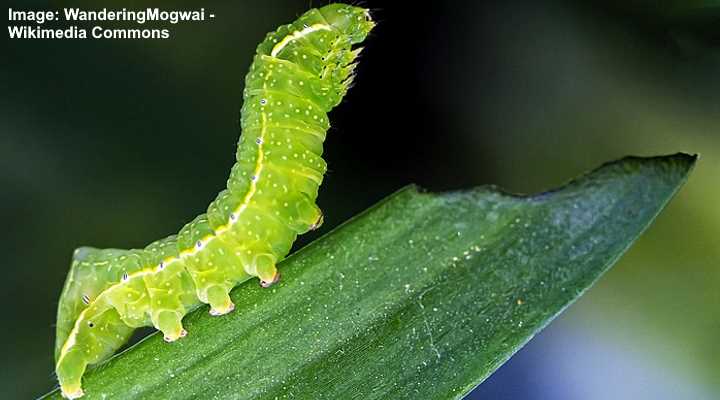
The yellow dotted green copper underwing caterpillar has yellow-white line along its sides and humped tail part
The copper underwing moth larva is a green caterpillar with an identifiable yellow and white band along its sides. In addition, on the colorful band are several blue dots with a white rim. The caterpillar’s green abdomen is also covered in yellow dots and patterns.
The copper underwing green caterpillar measures 1.77” (4.5 cm) long. The larva is also identified by its conspicuous humped tail part and rounded green head. The caterpillar is active in spring, feeding on fruit trees, hawthorn, maple, oak, and other deciduous trees.
Green Caterpillar Identification
The copper underwing moth caterpillar is a plump caterpillar with a green body covered in yellow dots and a white and yellow line running the length of its sides.
- Adult Stage: Develops into the copper underwing moth
- Caterpillar Feeds on: Various deciduous trees and shrubs
- Habitat: Found in woodlands and gardens where host plants grow
- Stinging: Does not sting
- Rarity: Commonly encountered in parts of North America
Oleander Hawk Moth Caterpillar (Daphnis nerii)
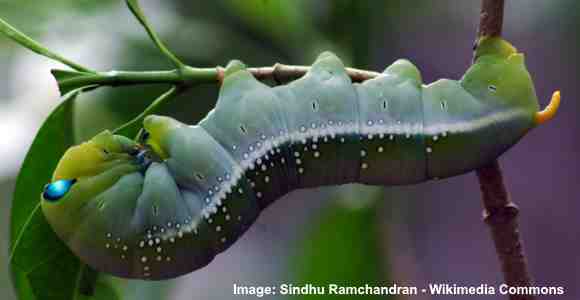
The large green oleander hawk caterpillar has pale orange horn at its tail end and blue eyespots
The oleander hawk moth caterpillar is a relatively large caterpillar with a green body, yellow fleshy horn at its rear, and two large blue and white eyespots. The fascinating caterpillar also has a white and pale blue stripe along its side decorated with white dots.
The oleander hawk moth caterpillar measures 3” to 3.3” (7.5 – 8.5 cm) long. Just before pupating, the caterpillar turns a dark charcoal color with orange patches at either end.
Green Caterpillar Identification
The oleander hawk moth caterpillar is identified as a large, horned caterpillar that is a vibrant green color with a band of blue and white markings along its side.
- Adult Stage: Transforms into the oleander hawk moth
- Caterpillar Feeds on: Leaves of oleander and other plants
- Habitat: Found in areas where oleander plants are present
- Stinging: Does not sting
- Rarity: Common in Africa, Asia and Hawaii.
Box Tree Caterpillar (Cydalima perspectalis)
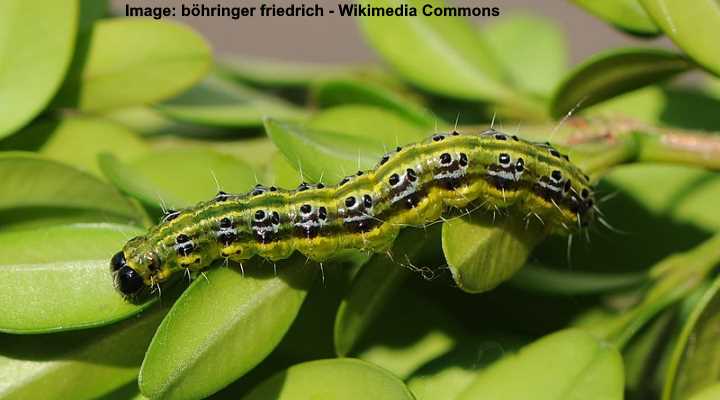
The box tree caterpillar has a green, black and yellow striped body with black spots and fine hairs
The box tree larva is a black, yellow, and green striped caterpillar. The identifying features of this green caterpillar are its round black head with a white “V” pattern, green, yellow, and black bands along its abdomen, and black dots on its back. In addition, the caterpillar has fine white spines.
The green and black box tree caterpillar grows 1.5” (4 cm) long. As its common name suggests, the striped, green caterpillar feeds on plants in the Buxus species. In some cases, the green caterpillars can completely defoliate boxwood shrubs.
Green Caterpillar Identification
The box tree moth caterpillar is identified by its cylindrical shape, black head, and green striped body. There are also black dots on its abdomen, each producing fine setae.
- Adult Stage: Develops into the box tree moth
- Caterpillar Feeds on: Leaves of boxwood (Buxus) plants
- Habitat: Found in gardens and areas with boxwood cultivation
- Stinging: Does not sting
- Rarity: Considered invasive and spreading in parts of Europe
Promethea Silkmoth (Callosamia promethea)
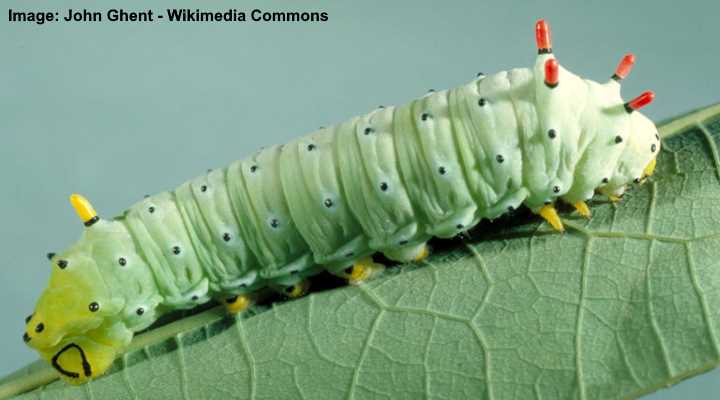
The pale green promethea silkmoth caterpillar is identified by four red horns at its head and yellow horn at the tail
The promethea silkmoth caterpillar is a pale bluish-green fat caterpillar with four conspicuous red rounded horns at its head and a yellow tail. In addition, the caterpillar has lines of bluish-black tubercles along its sides and back. You’ll also notice that its forelegs and prolegs are a pale-yellow color.
The promethea silkmoth caterpillar grows 1.77” to 2.36” (4.5 – 6 cm) long. These large, plump green caterpillars feed on the leaves of various deciduous trees and ornamental plants. It also feeds on the spicebush (Lindera benzoin), which gives it its other common name, the spicebush silkmoth caterpillar.
Green Caterpillar Identification
The promethea silkmoth caterpillar is identified by its four bright red protuberances on its head, blue-green body, and yellow tail.
- Adult Stage: Transforms into the promethea silkmoth
- Caterpillar Feeds on: Leaves of various deciduous trees, including cherry and oak
- Habitat: Found in woodlands and gardens where host trees grow
- Stinging: Does not sting
- Rarity: Commonly seen in parts of North America
Virginia Creeper Sphinx Moth Caterpillar (Darapsa Myron)
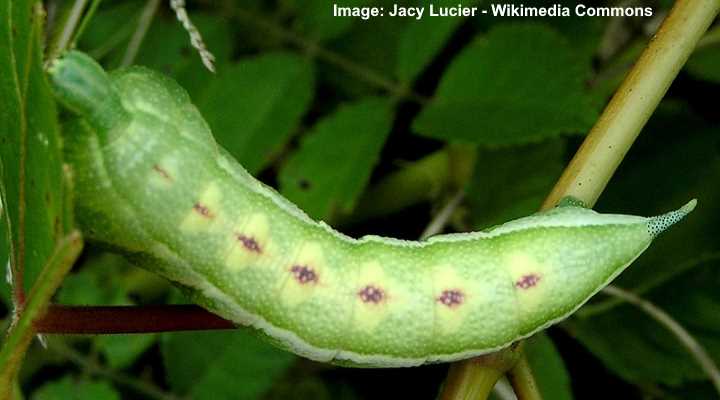
The green Virginia creeper sphinx moth caterpillar has brownish spots on its back and pale lines on its side
The larva of the Virginia creeper sphinx moth is a green caterpillar with a large head. Identifying marks of this moth caterpillar are its reddish-brown markings on its back, faint pale green speckles, and bulging head. The green caterpillar also has yellowish green streaks on its side.
The Virginia creeper sphinx caterpillar is a horned green caterpillar that grows 2” (5 cm) long. Its host plants are typically Virginia creeper (Parthenocissus quinquefolia) and grape leaves (Vitis). The caterpillars are common in the eastern United States, from Florida to Maine.
Green Caterpillar Identification
The Virginia creeper sphinx caterpillar is identified by its enlarged head, brownish dorsal markings, and pointed tail.
- Adult Stage: Develops into the Virginia creeper sphinx moth
- Caterpillar Feeds on: Leaves of Virginia creeper and related plants
- Habitat: Found in woodlands and areas with Virginia creeper vines
- Stinging: Does not sting
- Rarity: Commonly encountered in eastern North America
Gray Furcula Moth Caterpillar (Furcula cinerea)
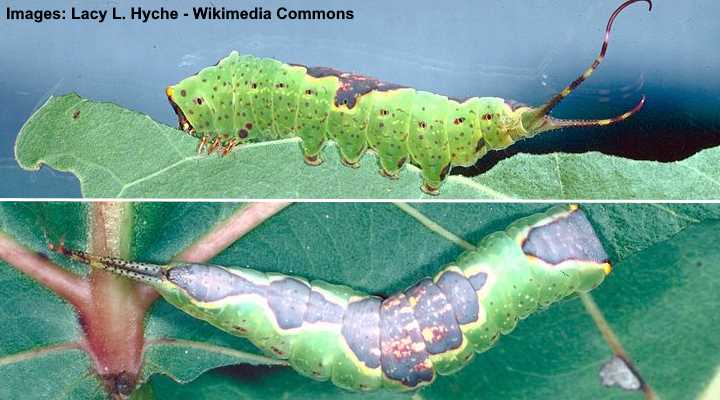
The gray furcula moth caterpillar is easily identified by its green body with dark brown marking on its back and forked tail
The gray furcula moth caterpillar is an unusual green caterpillar due to the large blackish-brown irregularly shaped markings on its back. The black splotches have yellow margins with orange and yellow marks in the center. In addition, the strange green caterpillar has an elongated pointed tail and flattened head.
Other unusual features of this green and brown caterpillar are its long, narrow tail-like projections and the brown, red, and green rings. Its side is also speckled with brown and orange dots.
Green Caterpillar Identification
The gray furcula moth caterpillar has several features making it easy to identify. Its green abdomen has large brownish-black patches with faint orange marks. In addition, its tail end has projections that look like a forked tail.
- Adult Stage: Transforms into the gray furcula moth
- Caterpillar Feeds on: Leaves of various deciduous trees, including oak and maple
- Habitat: Found in woodlands and gardens where host trees grow
- Stinging: Does not sting
- Rarity: Commonly found in parts of North America
Snowberry Clearwing Moth Caterpillar (Hemaris diffinis)
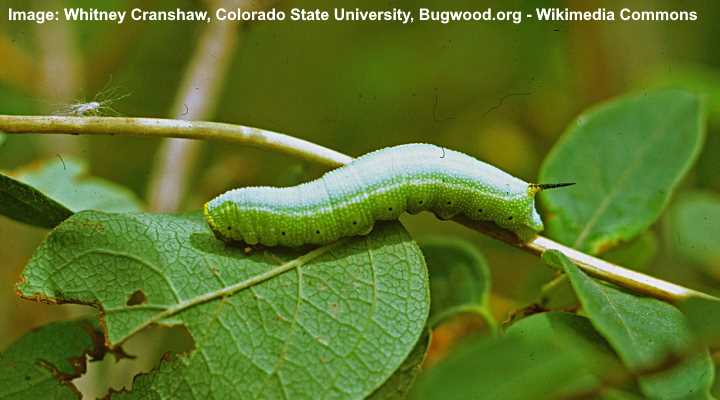
The green snowberry clearwing caterpillar’s body is covered with tiny white spots and it has a black horn at its tail end
The snowberry clearwing caterpillar is a pale lime-green caterpillar. The moth larva has a pronounced black tail spike, green and yellow longitudinal bands, and a row of bluish-black dots along its sides. In addition, tiny white granular spots cover the green caterpillar. In some cases, the larva grows as a brown caterpillar.
This green caterpillar is a type of hornworm due to its pointed black tail with a yellow band at its base. The larvae of the snowberry clearwing moth typically feed on honeysuckle, lantana, thistles, Canada violet, and lilac plants.
Green Caterpillar Identification
The snowberry clearwing moth caterpillar has a green body with a yellow band behind its head, black spots along its abdomen, and a black spike for a tail.
- Adult Stage: Develops into the snowberry clearwing moth
- Caterpillar Feeds on: Leaves of honeysuckle and related plants
- Habitat: Found in gardens, woodlands, and areas with honeysuckle vines
- Stinging: Does not sting
- Rarity: Commonly seen in North America
Bedstraw Hawk-Moth Caterpillar (Hyles gallii)
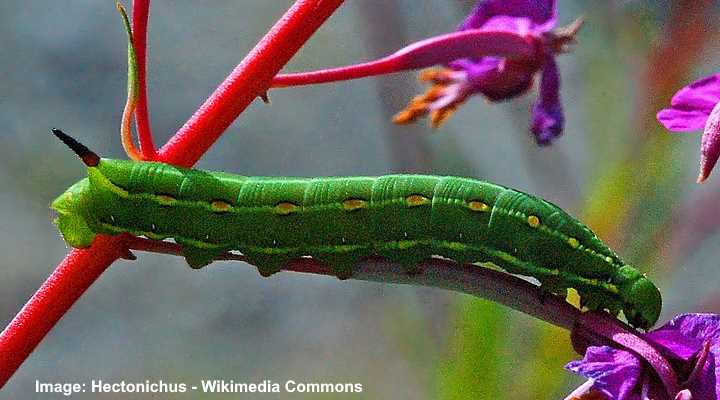
The bedstraw hawk moth caterpillar is a large green caterpillar with yellow lines and spots and reddish tail horn
The larva of the bedstraw hawk-moth is a green hornworm with a dark green abdomen and bands of bright creamy-yellow spots along its body. Other notable features of this spotted green caterpillar are its arched red tail horn, bluish-green head, and black prolegs. The large green caterpillar grows up to 3.1” (8 cm).
The bedstraw hawk-moth caterpillar can also be a black caterpillar with yellow spots or a yellow-spotted orange caterpillar. You’ll find the long cigar-shaped larva feeding on fireweed, bedstraw, fuchsia, and Plantago plants.
Green Caterpillar Identification
The bedstraw hawk-moth caterpillar is a large green cylindrical caterpillar, identified by its bands of yellow spots along its side and pronounced bright red tail.
- Adult Stage: Transforms into the bedstraw hawk-moth
- Caterpillar Feeds on: Leaves of bedstraw and related plants
- Habitat: Found in a variety of habitats, including meadows and grasslands
- Stinging: Does not sting
- Rarity: Commonly encountered in parts of North America
Georgian Prominent Caterpillar (Hyperaeschra georgica)
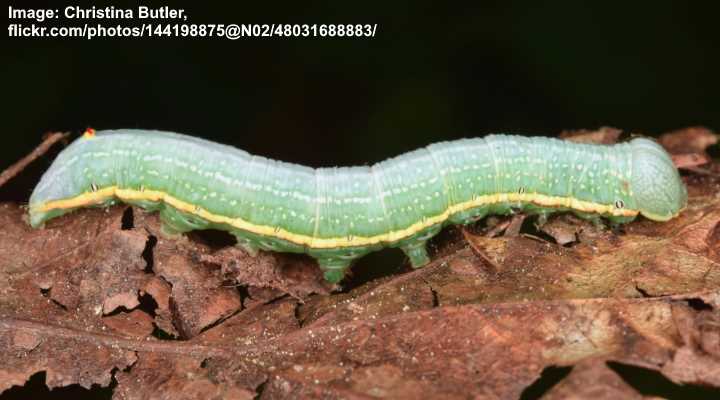
The pale green Georgian prominent caterpillar has a yellow line at its sides and orange bump at its tail end
The larva of the Georgian prominent moth is a large pale green caterpillar with a continuous yellow band along its body. In addition, this long caterpillar has bands of small faint green splotches along its back. An identifying feature of the green caterpillar is its orangish-red bump at its tail end.
The Georgian prominent moth caterpillar feeds on deciduous trees throughout North America.
Green Caterpillar Identification
The Georgian prominent caterpillar has a whitish-green body with a pronounced yellow, red-edged stripe along its sides just above its legs.
- Adult Stage: Develops into the Georgian prominent moth
- Caterpillar Feeds on: Leaves of various deciduous trees and shrubs
- Habitat: Found in woodlands and gardens where host plants grow
- Stinging: Does not sting
- Rarity: Found in North America and parts of Australia
Lacecapped Caterpillar (Oligocentria lignicolor)
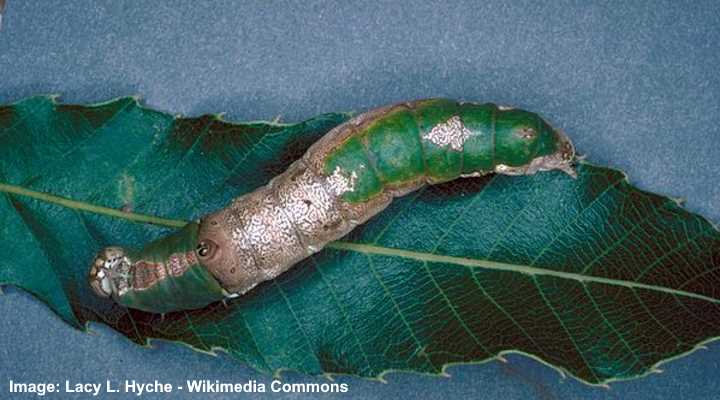
The green lacecapped caterpillar can be easily recognized by its silvery blotch on its back and sides
The lacecapped moth larva is a green caterpillar that resembles bird poop. The fat, cylindrical dark green caterpillar has a large grayish-white blotch on its back and sides. The green, white, and brown mottled patterns help to camouflage the caterpillar to protect it from predators.
The lacecapped green caterpillar grows up to 1.77” (4.5 cm) long. You will commonly find it gorging on leaves growing on beech, oak, and chestnut trees.
Green Caterpillar Identification
The lacecapped moth caterpillar is a large green caterpillar with recognizable mottled gray blotches on its back and sides.
- Adult Stage: Transforms into moth species within the Oligocentria genus
- Caterpillar Feeds on: Leaves of deciduous trees and shrubs
- Habitat: Found in woodlands and gardens where host plants grow
- Stinging: Does not sting
- Rarity: Commonly found in found in parts of North America
Frequently Asked Questions about Green Caterpillars
Are green caterpillars worms?
Although some green caterpillars are referred to as worms, they are in a different class. Caterpillars such as inchworms and cabbage worms belong to the class Insecta. Worms are a species of invertebrate in the class Clitellata.
Why are caterpillars green?
Many caterpillars are green because it is a great camouflage mechanism in the wild. Some green caterpillar species have special markings to frighten off prey or make them look like venomous creatures.
Are green caterpillars poisonous?
Generally, green caterpillars are not poisonous. Some species ingest toxic substances from plants to give them a bitter taste to any animal that may want to eat them. Most green caterpillars don’t sting or bite.
What do green caterpillars eat?
Like most moth or butterfly larvae, green caterpillars need to gorge on plant food to increase their weight. This gives them enough energy to metamorphose into beautiful flying insects. Caterpillars tend to munch their way through leaves on the host plant. Only if there is a large infestation of caterpillars, will they do extensive damage.
Related articles:

